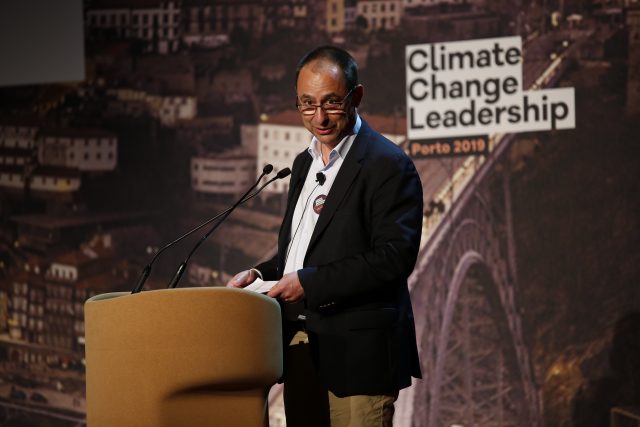An interview from Nick Breeze with Chef de Cave at champagne Bollinger Gilles Descotes.
Nick Breeze (Twitter and Instagram.)
Published: 29 March 2019
www.secretsommelier.com
The Champagne region has overall taken a decisive stance on climate action and here Gilles Descotes from Champagne Bollinger tells the not often heard story of what is going on in the vineyards and what steps are being taken to reduce further impacts down the road.
Nick Breeze:
How do you see the impacts of climate change in the Champagne region?
Gilles Descotes:
It is very easy to see in Champagne in fact. We pick 18 days earlier than we did 30 years ago. We picked in August in 2003, 2007, 2011, 2017, 2018. The last time before this was 1893! So you see there is definitely an acceleration. It is obvious.
If you look at the juices, the grapes, and the wines, you can see some differences too. First one is about alcohol. We have a rise of about 1% natural alcohol in the last 30 years. At the same time, we lost about 1g per litre of total acidity. Because of carbon dioxide in the air, the yields are getting bigger, which is not such bad for people in Champagne.
So you see there are quite a few big changes.
Nick Breeze:
Can you highlight some of the strategies you have taken in the vineyard to adapt to climate impacts?
Gilles Descotes:
I will answer your question about adaptation but the first thing is really about mitigation because at this point it is possible but I am not worrying at all for the next 30 to 50 years to come. But then if you look over a longer time, it could be a real problem if we do nothing.
Wedding Planners LondonThe UK’s mosty sought after of all wedding planners, with many years experience working with a portfolio of clients from across the world. Putting perfection, pleasure and panache into your weeding plan
So, going back to adaptation, we are very lucky in Champagne to get what we call chalk. This is our white soil. This chalk is working like a sponge and like a radiator. It will get the water in and out, and it will get the temperature in and out.
It is really working very well for regulation. Even if it is very dry for 3 months, the vineyards are not suffering at all. If it rains a lot for 3 months, the vineyards are not suffering at all. So this is the main tool: chalk, and it is there!
For us, the big adaptation is about keeping freshness. As I told you, we have more sugar and less acid. Champagne is quite an acidic wine. So, what we have to do is to work in the vineyard to get grapes with more acidic.
In the vineyard, it is very easy… I say that but it is not easy at all. The solutions are not that difficult to understand but they are difficult to manage.

Gilles Descotes at the Climate Change Leadership conference in Porto. Photo credits to The Drinks Business.
Nick Breeze:
What we are talking about is that if you are getting less acidity and more sugar, you are getting style change?
Gilles Descotes:
Yes, you are right!
Nick Breeze:
You are getting less freshness or more body. How does that feed into the identity of your brand and the regularity of non-vintage champagne for example?
Gilles Descotes:
At this point, it is really not a problem. If you think about in Champagne 50 year ago, acidity was quite a problem. Getting ripe grapes was quite a problem. So now we are getting ripe, safe grapes. The acidity is down but it is still very high. The pH of our wines is still around 3, so it is still very acidic but it is still moving up and we have to be careful because if out moves up to fast then it is going to be a problem!
Nick Breeze:
The IPCC and the emissions trajectory and the pathway that we are on shows the temperatures are going up and will keep going up because we are not changing our behaviour. How does that fit into your planning and strategy because you are a long-term business?
Gilles Descotes:
That is the main problem. The long-term strategy is definitely about mitigation. The medium-term strategy is really about adaptation. If you think about adaptation, you can work the soil and if you work there soil you will get more acidic wine. You can change the rootstock that lets you pick a little bit later, in September, when it is cooler. You can pick very early in the morning or during the night to get fresh grapes.
You can change the density of the vineyard. In Champagne now it is very narrow, very high density. You can go to a large [spaced] vineyard and if you do that you know you will get more acid in the grapes.
So there are quite a few tools we can use. Of course, we can also think about old varieties and new varieties because in Champagne you have what you call the 4 forgotten varieties. Some of them are very interesting, like Petit Meslier and Arbane because they are very fresh. So you can move to other varieties that can give freshness too.
Nick Breeze:
If you do that, are you going to experience a shift in style, if this becomes a permanent thing? People who like Champagne Bollinger know what it tastes of and like it as it is…
Gilles Descotes:
You should come… we planted some Arbane and some Petit Meslier and we had some good results with that, so you should come and try and taste in Bollinger!
But you are right. It is about style, again but style is not only one thing. We can move things. We use a lot of reserve wine and we have a lot of ways, in the cellar too, to preserve this freshness.
❛ So, for the 20-30 years to come, I am not very worried but then after that, we have to be very careful.❜
Nick Breeze:
Do you think perhaps that the wines are becoming slightly more complex and more textured, and that the public actually like it? So maybe that is a slightly positive thing?
Gilles Descotes:
Yes, it is awful to say so but for Champagne, until now, and I not saying it is going to be the same in the future, it is quite good news. We are getting riper grapes, the acidity is still very high, and very regular harvest.
You know, if you look in the past, sometimes you were producing 2 tonnes per hectare and then the next year 12 tonnes, and then the next year 2 tonnes, and then a big frost, and so on. Now, all that is quite over.
For us, for Champagne, at this point, it is not such bad news.
Nick Breeze:
Are you looking at any interventions to combat hail or frost?
Gilles Descotes: We decided 15 years ago to do nothing against frost because we know that if you want to do something you will have to use a lot of fossil fuel energy. The only way to protect from frost in Champagne at that time is to burn fuel and to get the vineyard warm. It really uses a lot of energy and is not very good for our carbon footprint.
We do nothing against hail either.
Nick Breeze:
Consumers seem to be growing more concerned about climate change. How do you communicate what you are doing to customers who are starting to ask questions about carbon footprints, sustainability, and all these kinds of things?
Gilles Descotes: You know, at Bollinger, it is not just about the carbon footprint. It is about the environment and the carbon footprint ids a part of it. We were the first house in Champagne to get the certification High Environmental Value. We were the first house in Champagne to get the certification Sustainable Viticulture in Champagne.
We were the first house to calculate our carbon footprint in 2010 and then again in 2015 so we could show a decrease of 18% per bottle of our footprint. So we are doing things but it’s not always easy to communicate because when you say to people “We are doing this”, they say, “why aren’t you doing that?!” We stopped using all herbicides five years ago. We work all of our soils. We use a very very low amount of fungicides too. We reduced the amount by 35%. So we are using less energy and using fewer implements but maybe we are not very good and communicating that.
Nick Breeze:
I think the most important thing is talking about it. I think Champagne has come a long way in talking about climate change.
Gilles Descotes:
Yeah, I think Champagne was one of the first regions in the world. The first carbon footprint in Champagne was in 2003 and that time nobody really talked about climate change or global warming. They calculated the [regional] carbon footprint in 2013 and they did one last year and we are really going down, for all Champagne, which is really good!
Our objective for Champagne is what we call factor 4. This is to reduce all of our emissions in Champagne by 2050. At the moment we are at minus 25% so we still have minus 50% to reach but we are on a good road, yes!


 Foto AFP
Foto AFP